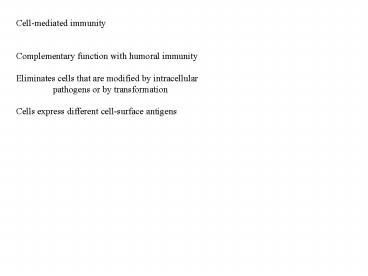Cell-mediated immunity - PowerPoint PPT Presentation
1 / 34
Title:
Cell-mediated immunity
Description:
Purpose: to see in vivo the effect of loss of. a particular function in the body ... In vivo assays. Graft-vs-host. If graft is immunocompetent and injected into ... – PowerPoint PPT presentation
Number of Views:37
Avg rating:3.0/5.0
Title: Cell-mediated immunity
1
Cell-mediated immunity Complementary function
with humoral immunity Eliminates cells that are
modified by intracellular pathogens or by
transformation Cells express different
cell-surface antigens
2
Antigen-specific and non-specific
mechanisms Cytotoxic T cells Natural killer (NK
cells) ADCC Delayed-type hypersensitivity Othe
r mechanisms
3
What distinguishes an effector T cell from
a naïve cell? Easier to activate More
cell-adhesion molecules makes it easier to
interact with target distinguishes target from
other cells Production of effector molecules
4
CD45 associates with TCR complex helps
with signal transduction These cells are more
sensitive to activation p. 320
5
Effector molecules On CTLs destroy target
cells On TH cells recruit or activate other
cells p. 321
6
Cytotoxic T cells Lyse altered-self cells Are
antigen-specific Are CD8 Are MHC-Class I
restricted (a few exceptions CD4 Class
II-restricted cytotoxic cells have been reported)
7
How are CTLs generated? Precursor cells must be
activated to become CTLs Antigen-specific
signal Co-stimulatory signal IL-2 induced
proliferation and differentiation
8
p. 322
9
IL-2 controls the activation stage When antigen
is cleared, Il-2 levels decline TH1 cells and
CTLs undergo apoptosis Nonspecific damage is
minimized How do CTLs actually destroy the
target cell?
10
Whats in those granules? (p. 325)
11
Perforin (forms pores) Granzymes These are
formed once the CTL precursor is activated Direc
tionality of pore formation and target
cell attack has been described
12
Cell-cell contact with target cell Requirement
for calcium (p. 327)
13
Another mechanism for CTL lysis has
been identified Fas-ligand/Fas receptor
interaction (p. 328)
14
By the way what is a knockout mouse? A
transgenic mouse in which a specific gene has
been inactivated Purpose to see in vivo the
effect of loss of a particular function in the
body
15
Transgenic mice may have incorporated the gene
anywhere. Objective is to express the gene. (p.
541)
To make a knockout mouse, specific gene
is targeted.
16
Variations on this technology have been used to
introduce novel genes into host animals e.g.,
transgenic pigs with human antigens chickens
that produce human Ig in egg yolks, etc.
17
p. 329
Summary of cytolytic pathways
18
Granzymes activate a series of proteases in the
target cell (Caspases) Starts a cascade that
ultimately leads to apoptosis CTLs dont kill
target cells they persuade them to commit
suicide.
19
Natural killer cells Tumor cell killing even in
unimmunized animals Cells responsible for this
are lymphocytic About 5-10 of circulating
lymphocytes
20
Early response to infection (p. 330)
21
Features of NK cells Related to T cells, but
also have some monocyte- like features Have CD2
and an IL-2 receptor like T cells Have CD16 (an
Fc receptor) like monocytes No thymic development
22
How do NK cells kill? Cytotoxic granules dont
require activation like CTLs dont have CD3 or
TCRs not MHC-restricted no memory So how is NK
activity restricted to target cells?
23
p. 333
24
Inhibitory signals prevent killing of cells that
have normal levels of MHC class I Interaction
between activation receptors and target ligands
can contribute to NK activation
25
Fc receptors on NK cells (as well as on
other effector cells) can contribute to
ADCC (antibody-dependent cell-mediated cytotoxic
ity) Various lytic substances do the rest
26
p. 334
27
How do you measure the activity of these
cells? MLR (mixed-lymphocyte response) In vitro
cytotoxicity assays In vivo systems
28
MLR Combination of allogeneic spleen cells in
culture T cells will rapidly divide and
differentiate Experimental system can measure
degree of response Can be an indicator of
tissue compatibility
29
p. 335
30
Class II mismatches p. 335
31
(No Transcript)
32
Cell-mediated cytotoxicity assays Vary
effector-to-target ratios Characterize cytoxic
cells (MHC restriction, e.g.) Specificity
33
In vivo assays Graft-vs-host If graft is
immunocompetent and injected into host, graft
cells will attack host tissue If host is immune
compromised, lymphocyte response is attributable
to graft cells Measure spleen enlargement (due
to proliferation of lymphocytes) Probably CTLs,
TH and NK cells all respond
34
Effector activities, continued Delayed-type
hypersensitivity (DTH) Due to a subset of TH1
cells Release cytokines that produce
localized inflammatory response Can cause some
tissue damage, but is usually minimal Role in
defense against certain types of antigens First
seen against M. tuberculosis































